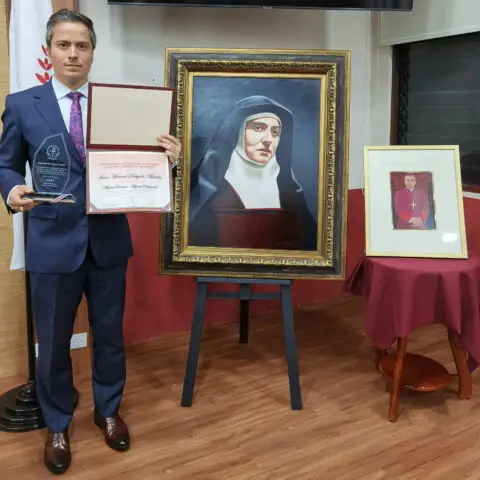When you think about art, many things surely go through your head, but this is a concept that the painter Juan Manuel Delgado has very well defined when, through his inspiration, he captures part of his life and also portrays our country through his canvases.
On this occasion, the Costa Rica News team has the opportunity to have a close encounter with Delgado, where, through a dynamic of questions and answers, the artist seeks to inspire anyone with his testimony.
1. Talk about your beginnings as an artist?
Like the majority of professional artists, I began drawing at a very young age.I moved to Canada with my parents and brother parents and brother at the age of around 3 and stayed there until I finished my university studies. I studied art under the supervision of my teacher and mentor, Peter Schwartzman, a Canadian architect and visual artist of Russian origin, who showed me all the techniques, starting with drawing in pencil, charcoal, watercolor, pastel and eventually evolving towards oil painting. With my love for drawing, I decided at that time to study architecture at Carleton University where the school’s philosophy was very focused on achieving maximum excellence through drawing and imagination.Upon graduating, I returned to Costa Rica to pursue a professional career as an artist, where I continued my studies under the guidance of therenowned portrait painter, Gonzalo Morales Sáurez.

Veteran of 7 Space Shuttle missions, tying the record, as of 2021 for the most spaceflights (a record set by Jerry L. Ross), 3rd Latin American, but the first Latin American immigrant NASA Astronaut selected to go into space, Member of the NASA Astronaut Hall of Fame
2. What do you remember most about that time?
I would spend countless hours studying the techniques and styles of the great masters, particularly those of Rembrandt, Velazquez and Caravaggio. I knew in my heart that painting was my true calling and I was determined to improve my skills and develop my own unique artistic voice. Of course, the path to becoming a professional artist was not without its challenges. There were moments when I felt completely stuck, unable to translate the images in my mind onto the canvas. The frustration of not being able to achieve the level of realism or expression I was seeking was, at times, overwhelming.

Professional Soccer Goalkeeper of the National Soccer Team of Costa Rica and the following teams: Paris Saint-Germain (2019 – 2024), Real Madrid (2014 – 2019), Levante (2011 – 2014), Albacete (2010 – 2012), Saprissa (2005 – 2010)
3. How does Juan Manuel Delgado define his success?
As a portrait painter, success is not simply defined by the number of commissions or accolades received. True success lies in the artist’s ability to continuously challenge themselves, evolve their craft, and create meaningful connections with their subjects. A successful portrait painter is one who strives to capture the essence and individuality of their sitters, not merely their physical likeness. They seek to imbue their work with emotion, depth, and a unique perspective that resonates with the viewer. Success is the mastery of technique and the relentless pursuit of personal growth and artistic exploration. Ultimately, the most successful portrait painters are those who never stop learning, who remain open to new challenges, and who use their craft as a means of self-expression and connection with the world around them.

4. What has been the most difficult thing about staying active during your career?
The long hours spent perfecting one’s craft and the meticulous attention to detail required to capture the nuances of the human form and facial features can be mentally and physically demanding. Unless one is an artist, one does not understand everything that goes into creating a work of art. The public usually only see’s the finished piece hanging in a museum or gallery. But it’s the story behind each brush stroke that truly defines a work of art.

5. What are your plans and projects for the remainder of this year?
This year, I will be having a solo exhibition at the National Gallery in Costa Rica, titled “Rhythms of Life,” from June 21 – July 21. A selection of oil paintings from my experiences living overseas in China and my experiences living back in Costa Rica will be on display in this exhibition.Through the expressive human form, these figurative pieces serve as a powerful testament towards my artistic journey, revealing how the rhythms of new environments, customs, and ways of being have profoundly shaped my artistic voice. Just as the heartbeat is the basis of our bodily existence, the rhythms of culture and personal growth form the essential fabric of the human experience. This exhibition invites viewers to interact with figurative narratives that pay homage to the primal rhythms that unite us all, regardless of geographic or cultural boundaries.

6. Let’s talk a little about the experience of painting the Pope?
The opportunity I had to paint a portrait of Pope Francis and present it to him in person was both an immense honor and a profound responsibility. During the painting process, I was driven by a fervent desire to immortalize not just his likeness, but the strength of his faith, the kindness of his heart, and the vision he embodies for a more just, merciful world. When I presented the painting to him at the Vatican, his warm, compassionate gaze and serene demeanor as he viewed his own reflection in the painting, radiated an inner light within me as he smiled with great satisfaction and thanked me for this work of art. I can only hope that those who see this painting, can witness the profound impact of his life and leadership – a legacy that will inspire generations to come.

7. What does Juan Manuel Delgado still have to do?
As a portrait painter, I understand that the journey of an artist is never truly complete. Even with years of experience and a portfolio of successful works, there is always more to learn and explore. The process of growth and improvement is a lifelong endeavor. One of the key things an artist must continue to do is to never stop learning. The world of art is vast and ever-evolving, and staying on the cutting edge requires a dedication to continuous learning. Whether it’s experimenting with new techniques, studying the work of masters, or exploring different mediums, the thirst for knowledge must remain unquenchable. Additionally, an artist must continue to dream big and set ambitious goals for themselves. Complacency can be the enemy of progress, and pushing the boundaries of one’s abilities is essential for reaching new creative heights.

Regarding the portrait painting of H.M. King Simeon II of Bulgaria, in a private audience, Juan Manuel became one of the youngest artists in history to have painted an official portrait of a King, only after Diego Velázquez, when he painted for the first time King Philip IV in 1623 at the age of 24
8. What do you say to all those passionate people like you who have a dream but don’t fight for it?
It is very easy to feel discouraged or insecure when you are starting a career as an artist. It is important to continue to honor one’s craft, stay true to your unique vision, and have faith in your abilities. Remember that success is not measured by external praise, but by the passion and authenticity you put into your work. It is important to have the humility to never stop learning and growing as an artist.If you truly believe in yourself, your dreams will continue to flourish.

9. We talked a little about your appreciation of art, what inspires you?
For me, as a portrait painter, the pursuit of growth and mastery is a constant source of inspiration. Delving into the complexities of the human face and form, I seek to bring the work to life, where I am driven to capture the unique essence and likeness of my subject with increasing skill, conveying the depth of emotion and personality that lies beneath the surface.It is this pursuit of perfection, this restless drive to continually improve, that fuels my creative fire.

10. What is the message you give to today’s youth to encourage them to focus on art before anything else?
Art is an incredibly valuable tool for young people to develop important lifelong skills. Through the creation of art, whether painting, drawing, music, dance or any other art form, young people will develop discipline and a sense of achievement. Participating in artistic activities requires concentration and dedication.Students must learn to persevere through challengesand see projects through to completion. Art also provides a healthy outlet for young people to express their emotions, ideas and perspectives.
11.What has been your biggest challenge in the artistic world?
Being an artist in the modern world presents a unique set of challenges. Art is often viewed as a slow and difficult career path, requiring years of dedicated skill development before an artist can hope to find success. The competition is fierce, with countless others vying for limited opportunities and recognition.Artists are often under tremendous pressure to balance their creative passions with more pragmatic considerations due to the harsh realities of earning a living as artists.The life of an artist is one of perseverance, resilience, and a deep, unwavering commitment to their craft.

12. How would you like your work to be remembered in the future?
As a portrait painter, I hope to be remembered for the depth and mastery in my work. I want my portraits to be windows into the past, allowing future generations to connect with the individuals I depicted and gain insight into the lives and experiences that made them unique. Though my own name may fade, I hope the legacies of the people memorialized in my art will endure, preserving their stories and inspiring others for centuries to come. That is the true legacy I wish to leave behind as a portrait painter.

13. Today and from this sector of society in which you develop (arts), what are the values that you bring to Costa Rica through your work? And which value is most important to you?
Through my portraits, I seek to capture the diversity of the people of Costa Rica, honoring their cultural origins, identities and unique experiences. An essential value in my work is the search for emotional connection and empathy through my portraits. I believe art is a universal language that fosters understanding and inspires positive social change. By creating portraits that capture the humanity and complexity of my subjects, I hope to play a role in cultivating a more empathetic, inclusive and harmonious society in Costa Rica.

14. Do you think Costa Rican society needs to support art more? If so, what would be your contribution to strengthen this sector?
As a portrait painter coming from a country like Costa Rica, the challenges can seem daunting at times. In a nation where the cultural spotlight is so often dominated by the fervor of other activities, the arts can sometimes feel like an afterthought, relegated to the margins of public consciousness. The lack of widespread support and appreciation for the visual arts can make it incredibly difficult for artists to gain the recognition and resources they need to truly thrive. Yet, despite these obstacles, the resilience and passion of Costa Rican artists shines through. Talent is abundant, with creative minds pushing the boundaries of what is possible, refusing to be defined by the constraints of their environment.

For those who have experienced shifts in consciousness and know that more peace, joy, and love awaits in a better living environment. A bold shared vision. A living community and hub for innovation. A sustainable ecosystem for living and working. A model for the new future.
– Advertisement –
Source link
Carlos Silva



